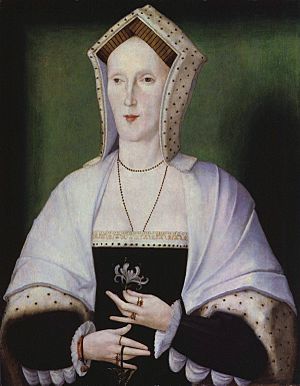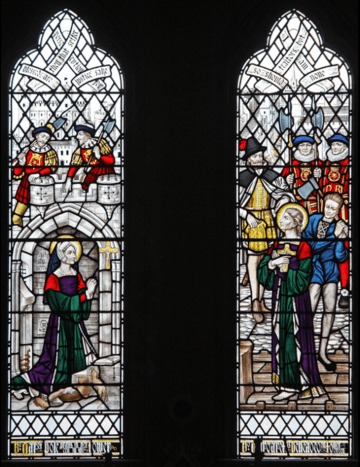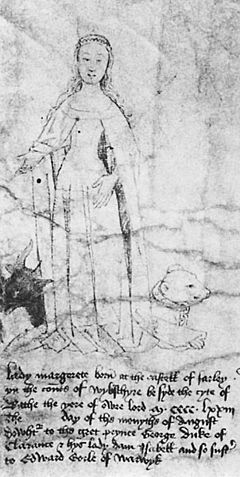Margaret Pole, Countess of Salisbury facts for kids
Quick facts for kids Margaret Pole |
|
|---|---|
| Countess of Salisbury Blessed |
|

Portrait of an unknown woman, often identified as the Countess of Salisbury
|
|
| Born | 14 August 1473 Farleigh Hungerford Castle, Somerset, England |
| Died | 27 May 1541 (aged 67) Tower of London, London, England |
| Noble family | York |
| Spouse(s) | Sir Richard Pole |
Issue
|
|
| Father | George Plantagenet, 1st Duke of Clarence |
| Mother | Isabel Neville |
| Blessed Margaret Pole |
|
|---|---|
An Icon of Blessed Margaret Pole
|
|
| Martyr | |
| Venerated in | Catholic Church |
| Beatified | 29 December 1886, Saint Peter's Basilica, Papal State by Pope Leo XIII |
| Major shrine | Church of Saint Peter ad Vincula, Tower Hamlets, London, United Kingdom |
| Feast | 28 May (ordinarily, her feast day would coincide with the day of her martyrdom, however 27 May was already in use as the Feast of Saint Augustine of Canterbury) |
| Attributes | Martyr's palm Rosary Tunic bearing the Five Wounds of Christ |
Margaret Pole, Countess of Salisbury (14 August 1473 – 27 May 1541) was the only surviving daughter of George Plantagenet, Duke of Clarence, a brother of Kings Edward IV and Richard III (all sons of Richard Plantagenet, 3rd Duke of York), by his wife Isabel Neville. Margaret was one of just two women in 16th-century England to be a peeress in her own right without a husband in the House of Lords. As one of the few members of the House of Plantagenet to have survived the Wars of the Roses, she was executed in 1541 at the command of King Henry VIII, the second monarch of the House of Tudor, who was the son of her first cousin Elizabeth of York. Pope Leo XIII beatified her as a martyr for the Roman Catholic Church on 29 December 1886.
Early life
Margaret was born at Farleigh Castle in Somerset, the only surviving daughter of George Plantagenet, Duke of Clarence, and his wife Isabel Neville, who was the elder daughter of Richard Neville, 16th Earl of Warwick, and his wife Anne Beauchamp, 16th Countess of Warwick. Her maternal grandfather was killed fighting against her uncle, Edward IV, at the Battle of Barnet. Her father, already Duke of Clarence, was then created Earl of Salisbury and of Warwick. Edward IV declared that Margaret's younger brother Edward should be known as Earl of Warwick as a courtesy title, but no peerage was ever created for him. Margaret would have had a claim to the Earldom of Warwick, but the earldom was forfeited on the attainder of her brother Edward.
Margaret's mother died when she was three, and her father had two servants killed who he thought had poisoned her. The Duke of Clarence plotted against Edward IV and in February 1478 was attainted and executed for treason; his lands and titles were forfeited. Edward IV died in 1483, when Margaret was ten. The next year, the late king's marriage was declared invalid by the statute Titulus Regius of 1484, making his children illegitimate, and since Margaret and her brother Edward were debarred from the throne by their father's attainder, their uncle Richard, Duke of Gloucester, was offered the crown and became king as Richard III. He was married to Anne Neville, a younger sister of Margaret's mother Isabel.
Richard III sent the children to Sheriff Hutton Castle in Yorkshire. In 1485, he was defeated and killed at the Battle of Bosworth by Henry Tudor, who succeeded him as Henry VII. The new king married Margaret's cousin Elizabeth of York, Edward IV's daughter, and Margaret and her brother were taken into their care. Soon young Edward, a potential York claimant to the throne, was moved to the Tower of London. Edward was briefly displayed in public at St Paul's Cathedral in 1487 in response to the presentation of the impostor Lambert Simnel as the "Earl of Warwick" to the Irish lords.
Shortly thereafter, probably in November 1487, Henry VII gave Margaret in marriage to his cousin, Sir Richard Pole, whose mother was half-sister of the king's mother, Margaret Beaufort. When Perkin Warbeck impersonated Edward IV's presumed-dead son Richard of Shrewsbury, 1st Duke of York, in 1499, Margaret's brother Edward was attainted and executed for involvement in the plot.
Richard Pole held a variety of offices in Henry VII's government, the highest being Chamberlain for Arthur, Prince of Wales, Henry's elder son. When Arthur married Catherine of Aragon, Margaret became one of her ladies-in-waiting, but her entourage was dissolved when Arthur died in 1502 aged fifteen.
When her husband died in 1505, Margaret became a widow with five children. She had a small estate of land, inherited from her husband, but no other income and no prospects. Henry VII paid for Richard's funeral. To ease the situation, Margaret devoted her third son Reginald Pole to the Church, in which he was to have an eventful career as a papal Legate and later as Archbishop of Canterbury. He was to resent her abandonment of him bitterly in later life. After her husband's death, Margaret had such inadequate means to support herself and her children that she was forced to live at Syon Abbey as the guest of the Bridgettine nuns. She remained there until she returned to favour when Henry VIII came to the throne in 1509.
Countess of Salisbury
Henry VIII married Catherine of Aragon himself in 1509, and Margaret was again appointed as one of her ladies-in-waiting. In 1512, an Act of Parliament restored to Margaret the Earldom of Salisbury and some of her brother's land which had belonged to it, for which she paid 5000 marks (£2666.13s.4d), equivalent to £1,163,097 in 2021. Henry VII had controlled them, first while her brother was a minor and then during his imprisonment, and had confiscated them after his trial. However, her brother's Warwick and Spencer [Despencer] estates remained in the hands of the crown.
As Countess of Salisbury, Margaret managed her lands well, and by 1538 she was the fifth richest peer in England. She was a patron of the new learning, like many Renaissance noblewomen; Gentian Hervet translated Erasmus' de immensa misericordia Dei (The Great Mercy of God) into English for her. Her first son, Henry Pole, was created Baron Montagu, another of the Neville titles; he spoke for the family in the House of Lords. Her second son, Arthur Pole, had a generally successful career as a courtier, becoming one of the six Gentlemen of the Privy Chamber.
Arthur Pole suffered a setback when his patron Edward Stafford, 3rd Duke of Buckingham, was convicted of treason in 1521, but he was soon restored to favour. He died young about 1526, having married the heir of Roger Lewknor; Margaret and her son Henry pressed Arthur's widow to take a vow of perpetual chastity to preserve her inheritance for her Pole children. Her daughter Ursula married the Duke of Buckingham's son, Henry Stafford, but after the Duke's fall, the couple was given only fragments of his estates.
Margaret's third son, Reginald Pole, studied abroad in Padua; he was Dean of Exeter and Wimborne Minster, Dorset, as well as a canon of York. He had several other livings, although he had not been ordained a priest. In 1529 he represented Henry VIII in Paris, persuading the theologians of the Sorbonne to support Henry's divorce from Catherine of Aragon. Her youngest son Geoffrey Pole married well, to Constance, daughter of Edmund Pakenham, and inherited the estate of Lordington in Sussex.
Margaret's own favour at Court varied. She had a dispute over land with Henry VIII in 1518; he awarded the contested lands to the Dukedom of Somerset, which had been held by his Beaufort great-grandfather—and were now in the possession of the Crown. In 1520, Margaret was appointed governess to Henry's daughter Mary; the next year, when her sons were mixed up with Buckingham, she was removed, but she was restored by 1525.
When Mary was declared a bastard in 1533, Margaret refused to give Mary's gold plate and jewels back to Henry. Mary's household was broken up at the end of the year, and Margaret asked to serve Mary at her own cost, but was not permitted. The Imperial Ambassador Eustace Chapuys suggested two years later that Mary be handed over to Margaret, but Henry refused, calling her "a fool, of no experience".
Fall
In 1531, Reginald Pole warned of the dangers of the Boleyn marriage. He returned to Padua in 1532, and received a last English benefice in December of that year. Chapuys suggested to Emperor Charles V that Reginald marry Mary and combine their dynastic claims. Chapuys also communicated with Reginald through his brother Geoffrey. Reginald replied to books Henry sent him with his own pamphlet, pro ecclesiasticae unitatis defensione, or de unitate, which denied Henry's position on the marriage of a brother's wife and denied the royal supremacy. Reginald also urged the princes of Europe to depose Henry immediately. Henry wrote to Margaret, who in turn wrote to her son a letter reproving him for his "folly". In May 1536, Reginald finally and definitively broke with the king. After Henry's second wife Anne Boleyn was arrested, and eventually executed, Margaret was permitted to return to Court, albeit briefly.
In 1537, Reginald (still not ordained) was created a Cardinal. Pope Paul III put him in charge of organising assistance for the Pilgrimage of Grace (and related movements), an effort to organise a march on London to install a conservative Catholic government instead of Henry's increasingly Protestant-leaning one. Neither Francis I of France nor the Emperor supported this effort, and the English government tried to have him assassinated. In 1539, Reginald was sent to the Emperor to organise an embargo against England—the sort of countermeasure he had himself warned Henry was possible.
As part of the investigations into the so-called Exeter Conspiracy, Geoffrey Pole was arrested in August 1538; he had been corresponding with Reginald, and the investigation of Henry Courtenay, Marquess of Exeter (Henry VIII's first cousin and Geoffrey's second cousin) had turned up his name. Geoffrey had appealed to Thomas Cromwell, who had him arrested and interrogated. Under interrogation, Geoffrey said that his eldest brother, Lord Montagu, and the Marquess had been parties to his correspondence with Reginald. Montagu, Exeter, and Margaret were arrested in November 1538.
In January 1539, Geoffrey was pardoned, but Margaret's son Henry, Baron Montagu (and cousin Exeter) were later executed for treason after trial. In May 1539, Henry, Margaret, Exeter and others were attainted, as Margaret's father had been. This conviction meant they lost their titles and their lands—mostly in the South of England, conveniently located to assist any invasion.
As part of the evidence for the bill of attainder, Cromwell produced a tunic bearing the Five Wounds of Christ, symbolising Margaret's support for Catholicism and the rule of her son Reginald and the king's Catholic daughter Mary. The supposed discovery, six months after her house and effects were searched at her arrest, is likely to have been a fabrication. She was sentenced to death, and could be executed at the king's will.
Margaret Pole, as she now was styled, was held in the Tower of London for two and a half years. She, her grandson Henry (son of her own son Henry), and Exeter's son were held together and supported by the king. She was attended by servants and received an extensive grant of clothing in March 1541. In 1540, Cromwell fell from favour and was attainted and executed.
Execution

The following poem was found carved on the wall of her cell:
For traitors on the block should die;
I am no traitor, no, not I!
My faithfulness stands fast and so,
Towards the block I shall not go!
Nor make one step, as you shall see;
Christ in Thy Mercy, save Thou me!
On the morning of 27 May 1541, Margaret was told she was to die within the hour. She answered that no crime had been imputed to her. Nevertheless, she was taken from her cell to the place within the precincts of the Tower of London where a low wooden block had been prepared instead of the customary scaffold.
Two written eyewitness reports survive of her execution: by Marillac, the French ambassador; and by Chapuys, ambassador to the Holy Roman Emperor. Their accounts differ slightly, with Marillac's report, dispatched two days afterwards, recording that the execution took place in a corner of the Tower with so few people present that, in the evening, news of her execution was doubted. Chapuys wrote two weeks after the execution that 150 witnesses had been present including the Lord Mayor of London.
Margaret was buried in the chapel of St Peter ad Vincula within the Tower of London. Her remains were uncovered when the chapel was renovated in 1876.
Her son, Reginald Pole, said that he would "never fear to call himself the son of a martyr". She was later regarded by Catholics as such and was beatified on 29 December 1886 by Pope Leo XIII. She is commemorated in the dedication of the Church of Our Lady Queen of Peace & Blessed Margaret Pole in Southbourne, Bournemouth.
Descendants
When not at Court, Margaret lived chiefly at Warblington Castle in Hampshire and Bisham Manor in Berkshire. She and her husband were parents to five children:
- Henry Pole, 1st Baron Montagu (c. 1492 – 9 January 1539), notable as one of the peers in the trial of Anne Boleyn; married Jane Neville, daughter of George Nevill, 5th Baron Bergavenny, and Joan Fitzalan, Countess of Hereford (also known as Joan of Arundel), with whom he had four children; executed by order of Henry VIII. A great-grandson of Henry Pole was Sir John Bourchier, one of the regicides of Charles I of England, who was a great-great-grandnephew of Henry VIII.
- Arthur Pole (before 1499 – before 1532), Lord of the Manor of Broadhurst in Sussex; married Jane Lewkenor, daughter of Sir Roger Lewkenor and the former Eleanor Tuchet, herself daughter of the 6th Baron Audley and the former Anne Echingham. They had four children.
- Reginald Pole (c. 1500 – 17 November 1558), cardinal, papal legate in various regions, including England, and the last Catholic Archbishop of Canterbury.
- Geoffrey Pole (c. 1501–1558), Lord of the Manor of Lordington in Sussex, suspected of treason by King Henry VIII and accused of conspiring with Charles V, Holy Roman Emperor; lived in exile in Europe; married Constance Pakenham, granddaughter and heir of Sir John Pakenham. John Pakenham was ancestor to Sir Edward Pakenham, brother-in-law to the Duke of Wellington.
- Ursula Pole (c. 1504 – 12 August 1570), married Henry Stafford, 1st Baron Stafford, and had some fourteen children.
Cultural depictions
- Margaret appears in William Shakespeare's 16th century play Richard III as the young daughter of the murdered Duke of Clarence.
- The character of Lady Salisbury in the Showtime series The Tudors, played by Kate O'Toole in 2007 and 2009, is loosely based on Margaret Pole.
- Janet Henfrey portrays Margaret in Episode 4 ("The Devil's Spit") of Wolf Hall, the 2015 BBC adaptation of Hilary Mantel's novels Wolf Hall (2009) and Bring Up the Bodies (2012).
- Margaret is the main character of Philippa Gregory's 2014 novel The King's Curse. She also appears in Gregory's novels The Kingmaker's Daughter (2012) and The White Princess (2013).
- Margaret was portrayed by Rebecca Benson in the television adaptation of The White Princess and by Laura Carmichael in the miniseries The Spanish Princess, a sequel to The White Princess.
- Margaret is the main character of Samantha Wilcoxson's 2016 novel, Faithful Traitor.
See also
 In Spanish: Margarita Pole para niños
In Spanish: Margarita Pole para niños


